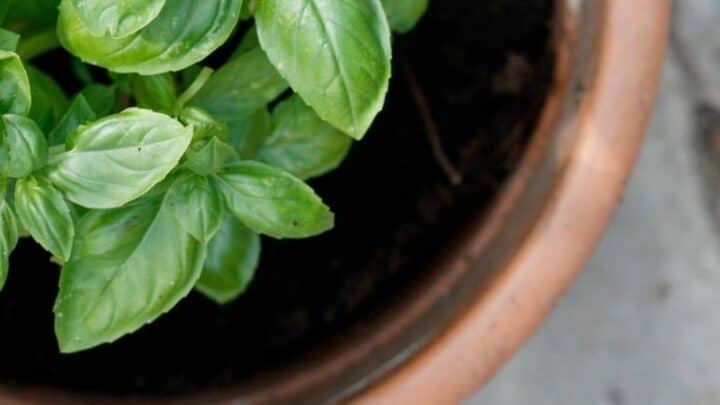Basil (Ocimumbasilicum) is a popular and incredibly fragrant herb that many gardeners love to grow.
Not only is it delicious as an herb and on pizza, pasta, and other foods, but it has many positive health benefits and is commonly used as an essential oil, too.
If you’ve ever grown basil, you know that it’s reasonably easy to grow as long as you remember to water it enough. Many people choose to grow this herb indoors, as it can easily thrive.
It’s so fragrant that you can smell the plant when you get within a few feet of it.
However, growing basil isn’t always easy. If your basil suddenly develops black spots, you’ve got a problem.
Basil can be very susceptible to certain diseases and fungi that cause black spots on the leaves and stem and could even kill your plant.
Why Does My Basil Have Black Spots All Over It
If your basil is covered in black spots, one of the most common causes is insect damage from blotch leaf miners. It could also be caused due to a bacterial or fungal disease such as fusarium wilt virus or leaf spot. Another cause of black spots is exposing your plant to very cold temperatures.
Common Causes of Black Spots on Basil
There are many reasons why your basil plant has black spots all over it. It also might havewilted or yellowing leaves. Here are some of the most common, including blotch leaf miners and other insects, disease, or even cold temperatures.
Blotch Leaf Miners and Other Insects
Leaf miners are a common insect that can cause a ton of damage to your basil plants. There are many different kinds of leaf miners, including the serpentine leaf miner and vegetable leaf miner.
However, the blotch leaf miner is the bane of basil growers everywhere and will kill your plant if allowed to flourish.
The larvae will tunnel or “mine” through the leaves, eating the nutritious plant matter until they’re ready to pupate. Once they’re ready, they drop to the soil and mature into adult flies, then start the process all over again.
The damage they cause will look like a black spot at first, and then it will grow and grow until there’s a whitish ring with an irregular border. These will appear on the lower leaves first, so pay close attention to your plant.
There’s also a chance that the black spots on yourbasilcould be caused by other insects, like aphids, whiteflies, or thrips. These can be controlled with handpicking or general insecticides.
Control Methods
While you might think that pesticide would be the best option, it won’t reach the larvae if it’s applied at the wrong time, and they’ll continue to grow. You can’t spray too early or too late, or it will be ineffective.
The best way to use pesticides on leaf miners is to pick off a few of the infected leaves and place them in the bag. It’s crucial to do this as early as possible.
When you see the tiny adult flies (they’re black in color), you know it’s time to spray the plant. Use the spray every day for a week for control.
One great way to control leaf miners is to pick off the infected leaves and throw them away. You can also get rid of anyeggs on the underside of leavesby wiping them off.
If you’re growing outside, row covers are another effective method. You can also tryneem oil,which is effective on many different types of insects.
Bacterial or Fungal Disease
Another common cause of black spots on your basil leaves is bacterial and fungal diseases.
枯萎病
Basil plants are vulnerable to fusarium wilt, which can cause a variety of damage to your plant. This includesbrown and black spotsor streaks on the leaves and stem, wilted leaves, premature leaf drop, and even twisted stems.
The cause of fusarium wilt is a fungus, and unfortunately, there is not control method or remedy for this fungal disease. You’ll have to destroy the infected leaves and plants.
Leaf Spot
Leaf spot is another common bacterial disease that can affect your basil plant and occurs when infected soil gets onto your plant’s leaves.
There are many different types of leaf spot bacteria, all of which can cause plant damage. Symptoms include black spots and streaks that appear on the leaves and stems.
The only way to control leaf spot is prevention. If your plant already has this bacteria, you’ll have to destroy it or at the very least remove the infected leaves.
You can also try to ensure that the plant gets plenty of air circulation and water it very carefully to avoid splashing soil up onto the leaves.
Cercospora Leaf Spot
这种类型的叶斑病菌, which can attack and damage basil. They love a warm, wet environment, so your plant will be particularly susceptible if you live in a humid area.
If you water your basil too much and only from the top, you’re inviting trouble in the form of Cercospora leaf spot.
这些真菌形成的黑色的斑点会ke big, black spots, slightly round in shape. They will also have a yellow border at first.
Then, once the fungi mature, they will cause a whitish-grey circle in the middle of the black spot. Eventually, the black area will crumble and fall away, leaving a hole.
To control Cercospora leaf spot is to trim away the infected leaves as soon as you spot them. You can also try certain fungicides. Look for a product with the active ingredient chlorothalonil and myclobutanil.
Cold Temperatures
Basil may be easy to grow, but they can be fragile when it comes to extreme temperatures.If basil is exposed toextremely cold temperatures, it can cause black spots to form on the leaves. However, there’s an easy way to tell if the black spots on your basil are caused by exposure to cold temperatures.
Look at the placement of the black spots: if they’re only on the edges and tips of the leaves, then it’s most likely caused by cold temperatures. The black edges will also look slightly crumpled.
Conclusion
Basil is one of the most versatile herbs and is used in thousands of dishes worldwide. It’s even used in essential oils and has many health benefits.
However, when your basil plant starts growing black spots, it could be due to numerous causes. The most common are insects, like the blotch leaf miner.
These pests tunnel through the leaves and can be controlled with certain insecticides or simply by pruning away infected leaves.
Black spots are also commonly caused by fungal and bacterial diseases, such as fusarium wilt virus and leaf spot. The problem could also be caused by exposing your basil to very cold temperatures, as they can be fragile in certain climate conditions.
It’s essential to look closely at the black spots on the leaves to identify the problem. If you don’t, you could waste time with ineffective treatments. In the meantime, the plant could die. So, the overall best general control method is to remove any infected leaves.
With the right treatment method, you can get your basil growing healthy again and smelling sweetly fragrant.

Daniel has been a plant enthusiast for over 20 years. He owns hundreds of houseplants and prepares for the chili growing seasons yearly with great anticipation. His favorite plants are plant species in the Araceae family, such as Monstera, Philodendron, and Anthurium. He also loves gardening and is growing hot peppers, tomatoes, and many more vegetables.


